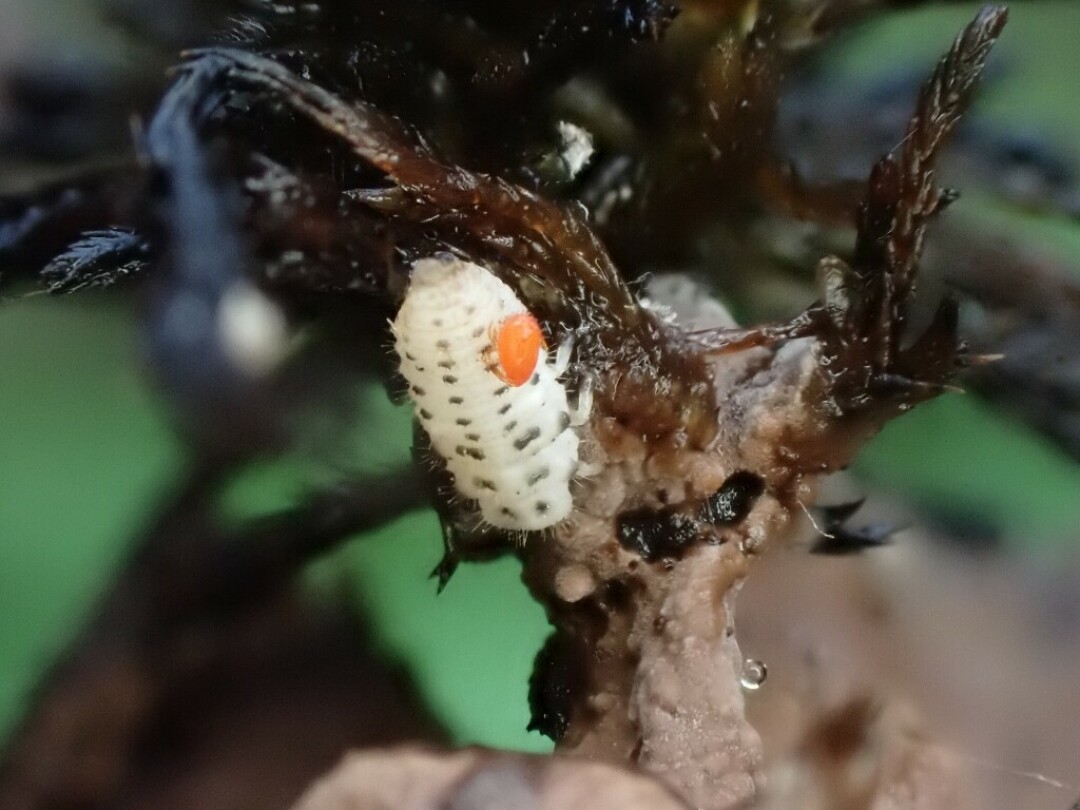News & Articles
Browse all content by date.

In the misty afternoon I decided it was time to get out for a walk. With raindrops still sparkling on everything, I slipped my little macro camera into my pocket, just in case some beauty caught my eye, and headed up the gravel road.
A bright spot gleamed, and I peered into the damp forest. White baneberry berries floated at knee-height in the gloom. Each of the six pearly berries had a dark spot in the center where the flower had attached, and the effect was like disembodied eyes looking back at me. Spooky!
For good reason, they are also known as Doll’s Eyes.
The spooky vibe continued when two cars came creeping down the road toward me, much slower than the usual locals. The windows rolled down – “Emily?” a voice came from the depths. And then I got a good look at the faces. My mushroom people! Who else would be driving slowly down a gravel road just days before the Annual Northwoods Foray put on by the Wisconsin Mycological Society but a bunch of the board members scouting locations? There was a seat open in the back, so naturally, I hopped into the car with them.
It was great to catch up with the crew as I guided them to the trailhead they were thinking of but couldn't quite remember how to get to. The mist thickened as we set off, but it didn’t deter anyone. Mushroom people like dampness just as much as the fungi they seek, and these folks were rehydrating after being in hot, dry weather farther south.
Out on the bog boardwalk at the Forest Lodge Nature Trail, I pointed folks toward a little patch of spoon-leaf sundew off a corner of the observation deck. These carnivorous plants catch insects in the sticky “dew” drops held at the tips of little hairs, and then digest them with enzyme-rich “dew.”
I was taught that these plants don’t need mycorrhizal relationships with fungi on their roots, because they could harvest nitrogen and phosphorus from insects. New DNA sequencing techniques have confirmed that they do indeed have a relationship with arbuscular mycorrhizal fungi, who penetrate their roots. The fungi probably gain sugars from the plant, and the plant might get nitrogen from the fungi.
As we were walking back on the boardwalk, some unusual brown patterns against the green of the Sphagnum caught my eye. Looking closer, I found some wrinkly, fuzzy, brown fungi. Later I’d discover these to be in the genus Thelephora, sometimes called Common Fiber Vase because of the narrow base and wide top, the spiraling cluster of layers, and the fuzzy edges. These fungi partner with pine trees – or maybe the spruce in this boggy forest – but unlike the arbuscular fungi who infiltrate the roots of a sundew, these ectomycorrhizal fungi form a web around cells in the tree root in order to trade nutrients.
From gazing out through the forest, to scanning the patch of fungi, I now picked up a single mushroom and looked even closer. A bright spot gleamed, and I peered into the damp brown layers. The small white grub had six legs and several rows of tiny black spots down its back. iNaturalist called it a Twenty-spotted Lady Beetle larva, and I’m not one to argue.
These insects are in Psyllobora, the genus of “fungus-eating lady beetles.” Most lady beetles are carnivores who eat other insects, and especially aphids, so this vegetarian option was news to me. Both the larvae and the adults eat powdery mildew, the white film that is the bane of many gardeners. Maybe they also eat the Fiber Vase? Or maybe a powdery mildew was growing on the brown surface beyond the reach of my eyes.
As I photographed the white larva, I noticed that an orange spot on their back had legs! A mite! When I asked a friend for an ID, he suggested that it might be a phoretic mite. Phoretic isn’t a species, but a lifestyle in which one critter hitchhikes on another but doesn’t parasitize them. This larva wasn’t going anywhere fast, but the beetle it will eventually become will fly away home.
Feeling squinty, I lifted my head to let my eyes rest on the soft greens and browns of the forest again. The tender light on the glistening surfaces made it feel like a fairyland.
As my mind wandered around all of the living beings hidden in that scene, the phrase “turtles all the way down” popped into my head.
Realizing I had only a sense of what it meant, I looked up the phrase. It is an expression of the problem of infinite regress. For example (according to Wikipedia) “a belief is justified because it is based on another belief that is justified. But this other belief is itself in need of one more justified belief for itself to be justified and so on.” The reference to turtles is based on the story of the Earth being built on turtle’s back. When asked what the turtle is standing on, the answer is “turtles all the way down.”
Here in this forest, the sequence isn’t all turtles. It’s spruce trees and raindrops and fungi and ladybugs and mites and weird friends and all the senses we have to perceive them. Throughout the entire universe, it’s relationships and connections all the way down.
Emily’s award-winning second book, Natural Connections: Dreaming of an Elfin Skimmer, is available to purchase at www.cablemuseum.org/books and at your local independent bookstore, too. For more than 50 years, the Cable Natural History Museum has served to connect you to the Northwoods. Our exhibit: “The Northwoods ROCKS!” is open through mid-March. Our Fall Calendar of Events is ready for registration! Follow us on Facebook, Instagram, YouTube, and cablemuseum.org to see what we are up to.
| Tweet |


